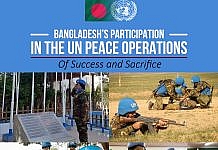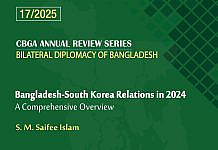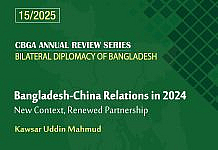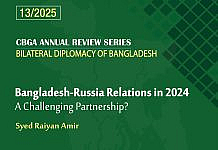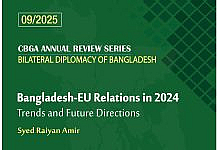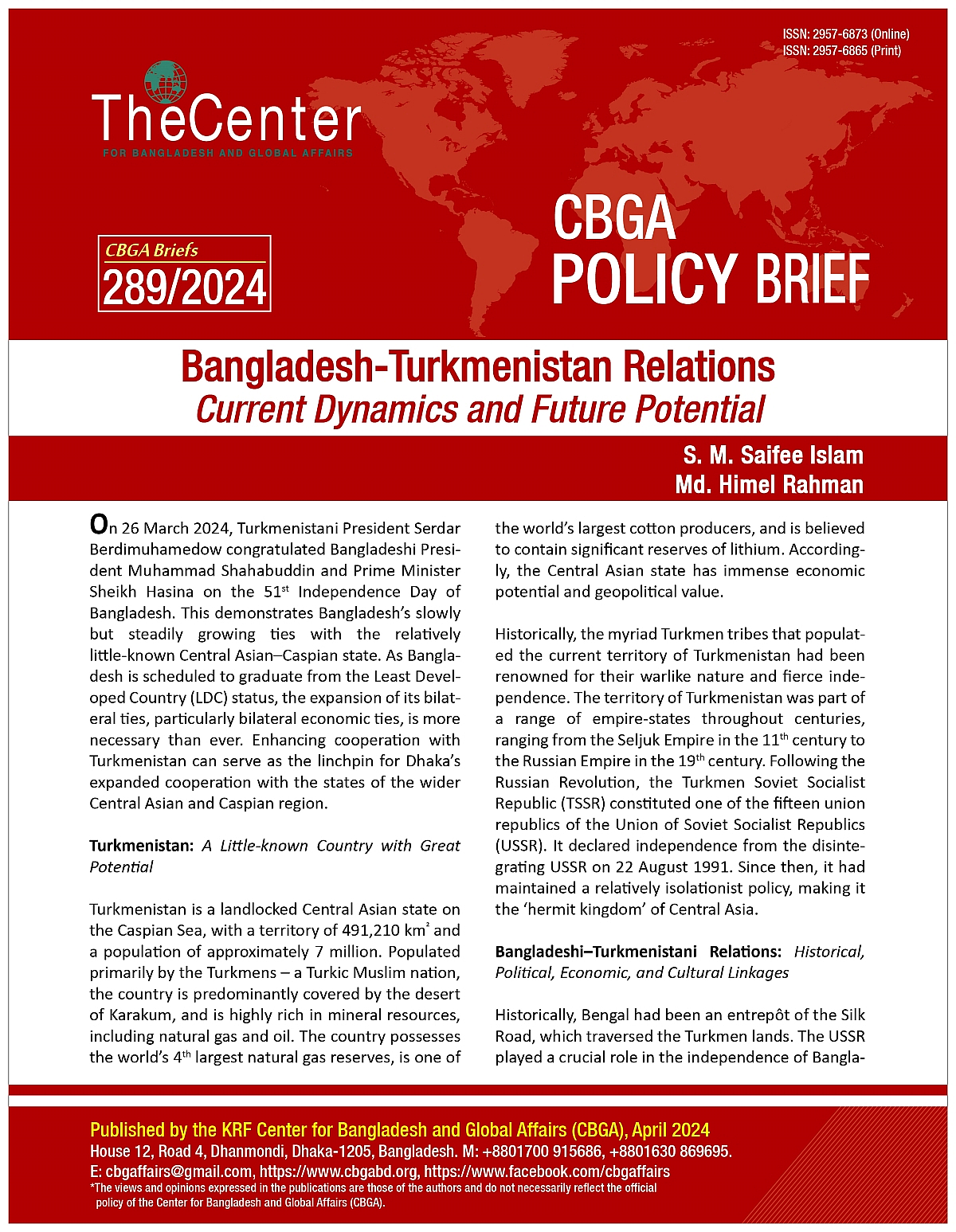
On 26 March 2024, Turkmenistani President Serdar Berdimuhamedow congratulated Bangladeshi President Muhammad Shahabuddin and Prime Minister Sheikh Hasina on the 51st Independence Day of Bangladesh. This demonstrates Bangladesh’s slowly but steadily growing ties with the relatively little-known Central Asian–Caspian state. As Bangladesh is scheduled to graduate from the Least Developed Country (LDC) status, the expansion of its bilateral ties, particularly bilateral economic ties, is more necessary than ever. Enhancing cooperation with Turkmenistan can serve as the linchpin for Dhaka’s expanded cooperation with the states of the wider Central Asian and Caspian region.
Turkmenistan: A Little-known Country with Great Potential
Turkmenistan is a landlocked Central Asian state on the Caspian Sea, with a territory of 491,210 km² and a population of approximately 7 million. Populated primarily by the Turkmens – a Turkic Muslim nation, the country is predominantly covered by the desert of Karakum, and is highly rich in mineral resources, including natural gas and oil. The country possesses the world’s 4th largest natural gas reserves, is one of the world’s largest cotton producers, and is believed to contain significant reserves of lithium. Accordingly, the Central Asian state has immense economic potential and geopolitical value.
Historically, the myriad Turkmen tribes that populated the current territory of Turkmenistan had been renowned for their warlike nature and fierce independence. The territory of Turkmenistan was part of a range of empire-states throughout centuries, ranging from the Seljuk Empire in the 11th century to the Russian Empire in the 19th century. Following the Russian Revolution, the Turkmen Soviet Socialist Republic (TSSR) constituted one of the fifteen union republics of the Union of Soviet Socialist Republics (USSR). It declared independence from the disintegrating USSR on 22 August 1991. Since then, it had maintained a relatively isolationist policy, making it the ‘hermit kingdom’ of Central Asia.
Bangladeshi–Turkmenistani Relations: Historical, Political, Economic, and Cultural Linkages
Historically, Bengal had been an entrepôt of the Silk Road, which traversed the Turkmen lands. The USSR played a crucial role in the independence of Bangladesh in 1971, and the Turkmen SSR had been a part of the USSR at that time. On 28 February 1992, Bangladesh recognized Turkmenistan as an independent state, becoming one of the first countries to establish diplomatic relations with the post-Soviet state. Interestingly, Bangladesh accorded recognition to Turkmenistan before countries such as Türkiye, the United States, India, and Pakistan did so, and thus had the potential to establish expansive ties with the newly independent country. However, Dhaka was slow to build upon its initial diplomatic initiatives vis-à-vis Ashgabat. So far, there is no Bangladeshi diplomatic mission in Turkmenistan, no direct flights from Dhaka to Ashgabat, and little cultural interactions between the two nations.
Yet, the two countries share several similarities. Both Bangladesh and Turkmenistan are Muslim-populated states with secular governments, and both constitute parts of the Global South. Since its independence in 1971, Bangladesh has pursued a non-aligned, usually balanced, and pragmatic foreign policy. Similarly, the policy of ‘permanent neutrality’ constitutes the cornerstone of Turkmenistani foreign policy, and this is not only enshrined in the country’s constitution but also recognized by the United Nations (UN). Bangladesh supported Turkmenistan’s bid to be internationally recognized as a neutral state at the UN and voted at the UN General Assembly (UNGA) in favour of the Turkmenistani proposal in 1995. Thus, the two countries share certain similarities in terms of their political outlooks, religio-cultural characteristics, and foreign policy orientations.
While the two countries do not yet have permanent diplomatic missions on each other’s territory, their senior officials often interact with one another. For instance, in November 2016, an aircraft carrying senior Bangladeshi officials, including Prime Minister Sheikh Hasina, had to make an emergency landing at the Ashgabat International Airport, and at that time, the Turkmenistani Deputy Prime Minister Baymyrat Hojamuhammedow called on the Bangladeshi Prime Minister. On 9 March 2018, Bangladeshi State Minister for Foreign Affairs Shahriar Alam met the Turkmenistani First Vice President and Minister of Foreign Affairs Raşit Meredow in Ashgabat and discussed potential sectors of bilateral cooperation, including energy, transport, investment, agriculture, chemical industry, and science and technology. Moreover, since his assumption of presidency on 19 March 2022, Turkmenistani President Serdar Berdimuhamedow has congratulated Bangladesh every year on its Independence Day.
|
Bangladeshi–Turkmenistani Trade Dynamics |
||
| Year | Import (USD) | Export (USD) |
| 2009 | 24,100,000 | 4,230 |
| 2012 | 83,682,108 | 4,779 |
| 2015 | 78,390,000 | 6,950 |
| 2022 | 1,080,996.62 | 214,738.20 |
The growing political interactions between Dhaka and Ashgabat are matched by the growth of their bilateral trade. Bangladesh primarily exports ready-made garment (RMG) products to Turkmenistan, while mostly importing raw cotton from the country. While Turkmenistan’s exports to Bangladesh have fluctuated over the years, Bangladesh’s exports to Turkmenistan have grown steadily. Meanwhile, cultural interactions between the two countries have been dominated by their participation in sports such as football. The two countries’ national football teams have played against each other in the AFC Asian Cup and other tournaments.
Exploring Future Prospects of Dhaka–Ashgabat Partnership
While the ties between Dhaka and Ashgabat have been slowly growing over the previous three decades, the bilateral partnership has considerable prospects for further expansion. Both Dhaka and Ashgabat stand to gain from such expansion of bilateral ties.
- Expanding the Trade in Cotton
Turkmenistan is one of the largest cotton producers in the world. It has become a significant player in the global cotton market, boasting a substantial production capacity and the potential for exporting. Over the span of five years, from 2018 to 2023, Turkmenistan has consistently achieved remarkable cotton production numbers, with an average yield of 910 thousand 480-lb bales. In addition, Turkmenistan’s impressive track record of maintaining consistent production levels in the 2022/2023 and 2023/2024 seasons, with 550 thousand hectares of cotton area and 900 thousand 480-lb bales of production, showcases the country’s unwavering commitment as a reliable cotton supplier.
Meanwhile, Bangladesh is the 3rd largest importer of cotton in the world, and cotton serves as one of the key raw materials for the country’s RMG industry. In the fiscal year 2022–2023, Bangladesh spent a staggering $8.67 billion for importing cotton. This clearly indicates the country’s strong dependence on foreign sources of cotton in order to fulfil the needs of its textile industry. The significant amount of money spent on importing cotton highlights the crucial need for Bangladesh to ensure a reliable and affordable source of raw materials for its textile industry.
Upon analyzing this data, it becomes clear that there is a notable potential for bilateral cotton trade between Bangladesh and Turkmenistan. Bangladesh’s strong demand for cotton creates a profitable opportunity for Turkmenistan’s cotton exports. With its strong production capacity and focus on exports, Turkmenistan is well-positioned to effectively meet Bangladesh’s cotton needs. In addition, fostering a stable cotton trade relationship between the two countries can result in mutual advantages. Bangladesh would have the opportunity to explore alternative sources for cotton imports, which would help decrease reliance on traditional suppliers and enhance the stability of its supply chain. Alternatively, Turkmenistan has the opportunity to explore new export markets and boost its revenue by expanding its market into Bangladesh.
- Enhancing Energy Cooperation
Turkmenistan, containing approximately 10% of the total natural gas reserves in the world, is a major hub of energy. On the other hand, ensuring the continuous flow of natural gas is crucial to Bangladesh’s economic growth. Natural gas is used in the country for generating electricity, running industries, operating commercial establishments, and cooking. To meet the growing demand, Bangladesh imports 300–400 million cubic feet of liquefied natural gas (LNG) daily from countries such as Oman and Qatar. Meanwhile, the domestic natural gas reserves in the country are dwindling, indicating that the country may need to import more natural gas in future. Bangladesh can import part of the required natural gas from Turkmenistan.
As Turkmenistan is landlocked, it can only export its natural gas through pipelines. Following its independence, Turkmenistan undertook measures to export its natural gas to a wide range of customers, including India and Pakistan. Accordingly, the Turkmenistan–Afghanistan–Pakistan–India (TAPI) Gas Pipeline project was initiated in 1995 in a bid to export natural gas from Turkmenistan to India via Afghanistan and Pakistan. So far, the pipeline has been built only partially and has not yet been extended into India owing to the protracted Indo–Pakistani geopolitical rivalry. However, if the pipeline is successfully extended into India, it would be possible to further extend the pipeline into Bangladesh. In such a scenario, Bangladesh would be able to use Turkmenistani natural gas to ensure its energy security, while Turkmenistan would be able to tap into a new and large market for its energy exports.
- Promoting Tourism
Currently, there is little flow of tourists between Bangladesh and Turkmenistan. However, there is considerable potential in this sector. Turkmenistan contains numerous historic sites, including the ancient Parthian capital of Nisa, the famed oasis-city of Merv, and the renowned Khwarezmian capital of Ürgenç. In addition, the country’s sprawling capital Ashgabat has acquired a reputation as the City of White Marble. Also, the Darvaza gas crater, famously known as the ‘Door to Hell,’ attracts many tourists. Hence, Turkmenistan can be an attractive venue for Bangladeshi tourists.
Meanwhile, Bangladesh contains numerous touristic sites, including the world’s longest beach in Cox’s Bazar, the world’s largest mangrove forest in the Sundarbans, the scenic beauty of Chattogram Hill Tracts (CHT), the attractive landscape of the Sylhet region, and the numerous historical sites throughout the country. The Turkmenistanis have a penchant for spending their vacations by the side of the sea, and tens of thousands of Turkmenistani citizens visit countries with warm seashores, such as Türkiye. Hence, Bangladesh can be turned into a potential destination for Turkmenistani tourists.
Through the removal or easing of visa restrictions, the start of direct flights, and proper advertising, Bangladesh and Turkmenistan can start the flow of tourists between the two states. This would be economically beneficial for both countries, enhance people-to-people interactions, foster cultural exchanges, and increase both countries’ soft power.
- Increasing Diplomatic Contacts
Bangladesh and Turkmenistan does not have any diplomatic mission on each other’s territory. At present, Bangladesh’s Ambassador to Türkiye is tasked with managing relations with Turkmenistan. Meanwhile, Turkmenistan’s Ambassador to India is presumably tasked with managing relations with Bangladesh. This hinders easy and direct interactions between the two countries. Hence, the two countries should undertake measures to upgrade their diplomatic ties by opening consulates, if not embassies, in each other’s capitals. This would facilitate easier communication between Dhaka and Ashgabat, and foster the development and expansion of economic and cultural ties between the two nations.
Conclusion
Bangladesh and Turkmenistan, with their similar religio-cultural features, common political values, and foreign policy outlooks, share a three-decades-old political and economic partnership. Through expanding cooperation in the cotton and energy sector and fostering tourism, as well as the consequent expansion of diplomatic ties, the two countries can take their mutually beneficial partnership to a new height.
– S. M. Saifee Islam is a Research Associate and Md. Himel Rahman is a Research Assistant at The KRF Center for Bangladesh and Global Affairs (CBGA).


